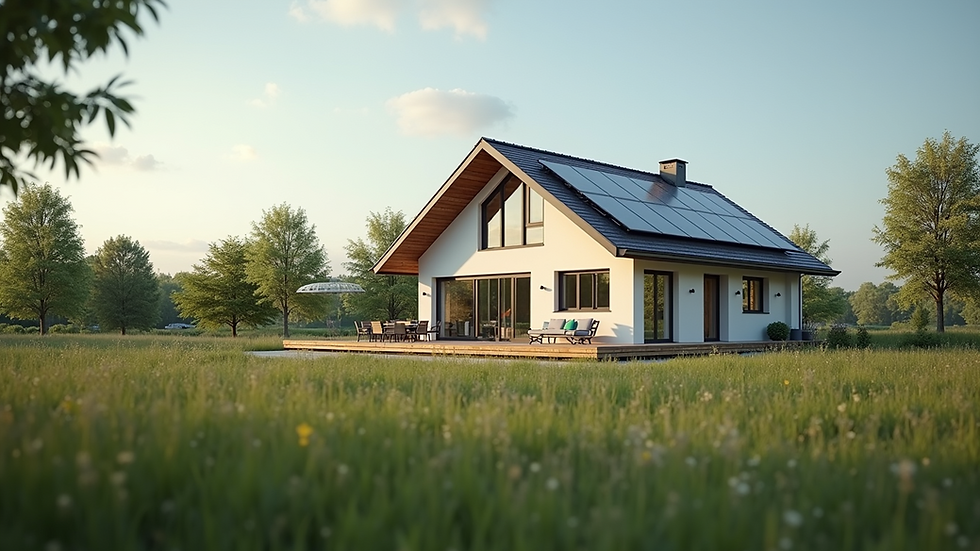Exploring the Innovations of Jovan Eco House
- Jovan Eco Hause
- 11 minutes ago
- 4 min read
Sustainable living is no longer just a trend but a necessity in today’s world. As environmental concerns grow, so does the demand for homes that reduce carbon footprints and promote energy efficiency. One remarkable example leading this movement is the jovan eco house. This innovative project combines cutting-edge technology with eco-friendly materials to create homes that are both comfortable and kind to the planet. In this article, we will explore the key innovations behind eco houses like those developed by Jovan Eco House, their benefits, challenges, and practical insights for anyone interested in sustainable living.
Groundbreaking Eco House Innovations
Eco house innovations focus on reducing energy consumption, using sustainable materials, and integrating smart technology to enhance living conditions. Here are some of the most notable innovations that define modern eco houses:
1. Energy Efficiency and Renewable Energy Integration
One of the core features of eco houses is their ability to minimize energy use. This is achieved through:
High-performance insulation: Using materials such as recycled cellulose or sheep wool to keep homes warm in winter and cool in summer.
Triple-glazed windows: These reduce heat loss and improve sound insulation.
Solar panels and solar water heating: Many eco houses incorporate photovoltaic panels to generate electricity and solar thermal systems to provide hot water.
Heat recovery ventilation systems: These systems recycle heat from stale air to warm incoming fresh air, reducing heating needs.
2. Sustainable Building Materials
Eco houses prioritize materials that have a low environmental impact. Examples include:
Bamboo flooring: A fast-growing, renewable resource.
Recycled steel and timber: Reduces the need for new raw materials.
Natural plasters and paints: Free from harmful chemicals and volatile organic compounds (VOCs).
3. Water Conservation Technologies
Water-saving innovations are essential in eco homes. These include:
Rainwater harvesting systems: Collect rainwater for garden irrigation or toilet flushing.
Low-flow fixtures: Reduce water use without compromising performance.
Greywater recycling: Treats and reuses water from sinks and showers for non-potable purposes.

The Impact of Eco House Innovations on Daily Living
Eco house innovations do not just benefit the environment; they also improve the quality of life for residents. Here’s how:
Lower utility bills: Energy-efficient designs and renewable energy reduce electricity and heating costs.
Improved indoor air quality: Natural materials and ventilation systems reduce allergens and pollutants.
Comfortable living environment: Better insulation and temperature regulation create a stable indoor climate.
Increased property value: Eco-friendly homes are increasingly sought after in the real estate market.
For example, a home equipped with a heat recovery ventilation system can maintain fresh air circulation without losing heat, making it ideal for colder climates. Similarly, solar panels can provide a significant portion of a household’s electricity needs, especially in sunny regions.
What is the disadvantage of eco homes?
While eco homes offer many benefits, they also come with some challenges that potential homeowners should consider:
1. Higher Initial Costs
Eco houses often require a larger upfront investment due to:
The cost of advanced materials like triple-glazed windows.
Installation of renewable energy systems such as solar panels.
Specialized construction techniques.
However, these costs are often offset over time by savings on energy bills and maintenance.
2. Design and Construction Complexity
Building an eco house requires careful planning and expertise. Not all builders have experience with sustainable materials or energy-efficient designs, which can lead to delays or increased costs.
3. Limited Availability of Materials
Some eco-friendly materials may not be readily available in all regions, potentially increasing transportation costs and environmental impact.
4. Maintenance Requirements
Certain systems, like rainwater harvesting or greywater recycling, require regular maintenance to function properly and avoid issues such as clogging or contamination.
Despite these disadvantages, many find the long-term benefits and positive environmental impact outweigh the initial challenges.

Practical Tips for Building or Buying an Eco House
If you are considering an eco house, here are some actionable recommendations to guide your journey:
1. Research Local Climate and Regulations
Understanding your local climate helps in choosing the right insulation, heating, and cooling systems. Also, check building codes and incentives for sustainable construction in your area.
2. Prioritize Energy Efficiency
Focus on airtight construction, high-quality insulation, and energy-efficient windows. These elements have the biggest impact on reducing energy consumption.
3. Choose Renewable Energy Sources
If possible, invest in solar panels or other renewable energy systems. Look for government grants or subsidies that can reduce installation costs.
4. Use Sustainable Materials
Opt for materials with low environmental impact and good durability. Ask your builder about sourcing and certifications.
5. Plan for Water Conservation
Incorporate rainwater harvesting and water-efficient fixtures to reduce water bills and environmental strain.
6. Work with Experienced Professionals
Hire architects and builders who specialize in eco-friendly construction to ensure your home meets sustainability goals.
7. Consider Smart Home Technology
Smart thermostats, lighting, and energy monitoring systems can optimize energy use and increase comfort.
By following these tips, you can create a home that is both environmentally responsible and enjoyable to live in.

The Future of Sustainable Living with Jovan Eco House
The innovations seen in projects like the jovan eco house represent the future of sustainable living. As technology advances and awareness grows, eco houses will become more accessible and affordable. These homes not only reduce environmental impact but also promote healthier lifestyles and financial savings.
Investing in an eco house today means contributing to a greener planet and enjoying the benefits of modern, efficient living. Whether you are building from scratch or retrofitting an existing home, embracing eco house innovations is a step toward a sustainable future.
By staying informed and making conscious choices, everyone can play a part in transforming the way we live and care for our environment.





Comments